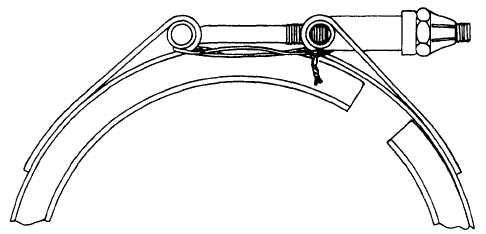2. Slide the sleeve (with the sleeve seal partially
installed) onto the line.
3. Position the split sleeves over the line beads.
4. Slide the sleeve over the split sleeves, and fold
over the sleeve seal so it covers the entire sleeve.
5. Install the coupling over the sleeve seal and
torque to correct value.
RIGID COUPLINGS.—The rigid line coupling
shown in figure 2-15 is referred to as a V-band
coupling. When you install this coupling in restricted
areas, some of the stiffness of the coupling can be
overcome by tightening the coupling over a spare set
of flanges and a gasket to the recommended torque
value of the joint. Tap the coupling a few times with
a plastic mallet before removing it.
When you install rigid couplings, follow the steps
listed below:
1. Slip the V-band coupling over the flanged
tube.
2. Place a gasket into one flange. One quick
rotary motion assures positive seating of the gasket.
3. Hold the gasket in place with one hand while
the mating flanged tube is assembled into the gasket
with a series of vertical and horizontal motions to
assure the seating of the mating flange to the gasket.
NOTE: View B of figure 2-15 shows the
proper fitting and connecting of a rigid
coupling using a metal gasket between the
ducting flanges.
4. While holding the joint firmly with one hand,
install the V-band coupling over the two flanges.
5. Press the coupling tightly around the flanges
with one hand while engaging the latch.
6. Tighten the coupling firmly with a ratchet
wrench. Tap the outer periphery of the coupling with
a plastic mallet to assure proper alignment of the
flanges in the coupling.
This will seat the sealing
edges of the flanges in the gasket. Tighten again,
making sure the recommended torque is not
exceeded.
7. Check the torque of the coupling with a torque
wrench and tighten until the specified torque is
obtained.
8. Safety wire the V-band coupling, as shown in
figure 2-16, as an extra measure of security in the
event of T-bolt failure. The safety wire will be
installed through the band loops that retain the T bolt
and the trunnion or quick coupler. A minimum of
two turns of the wire is required. Most V-band
connectors will use a T bolt with some type of
self-locking nut.
TAPER PINS.—Taper pins are used in joints that
carry shear loads and where the absence of clearance
Figure 2-16.—Safetying a V-band coupling.
2-13

